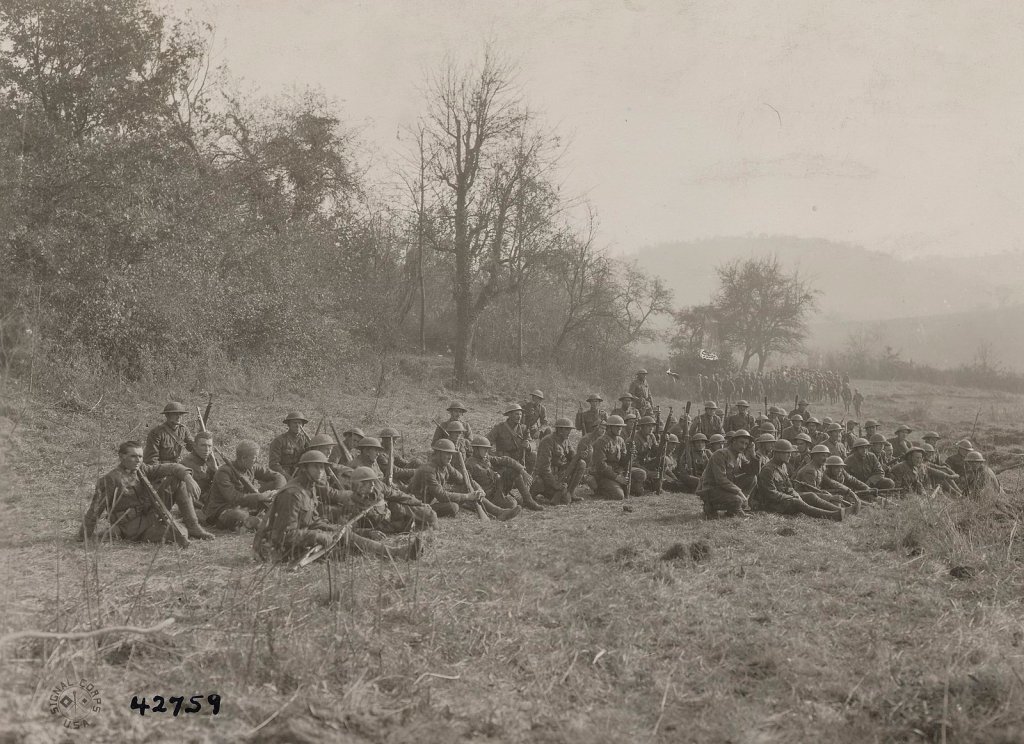Ever heard of the Lost Battalion? No, not lost like we don’t know anything about them … lost as in they got so turned around in a forest that they were legit lost. Now, you might be wondering how a unit of trained service members gets lost in the first place. Well, buckle up, warriors, because this tale is straight out of Hollywood.
We’re diving into the time machine again. Destination? The year 1918, a time when the world was neck-deep in the shadowy abyss of the Great War. In these shadows, our tale unfolds in a place known as the Argonne Forest, nestled in the heart of northeastern France. It was on this blood-soaked stage that a scrappy group of U.S. soldiers, who’d come to be known as the “Lost Battalion,” carved their names into the stone tablet of military legend. Under the command of Major Charles Whittlesey, these men, all 554 of them, walked into history’s hallowed hall, not through grand victories but through an extraordinary tale of resilience and survival.
The heart of the Argonne
In the labyrinthine wilderness of the Argonne, Whittlesey’s men, mostly from the 77th “Statue of Liberty” Division, were tasked with a daunting mission. Their objective? Pierce the enemy’s line, an important step in the Meuse-Argonne Offensive, the final Allied assault that hoped to knock the Central Powers off their feet. Little did they know that they were about to waltz into a German maelstrom that would give them an unwelcome title and unforgettable fame.
The unseen predicament
With the order “advance at all costs,” Whittlesey’s battalion moved forward with the spirit of warriors on October 2, 1918. They punched through the German line, but their flanks lost the dance. The supporting units had been repelled, leaving our gallant battalion isolated deep within enemy territory, surrounded by uninvited guests in spiked helmets. A dire situation? Oh, indeed. But, to surrender? That’s a word these brave souls didn’t care to thumb through in their dictionaries.
Defying death
Marooned within the gnarled tendrils of the Argonne Forest, our Lost Battalion found themselves in a situation best described as looking down the wrong end of a loaded gun. Ammo? As sparse as a hen’s teeth. Medical supplies? More akin to a meager pantry. And food? Sharing your rations with local fauna isn’t exactly what they had in mind when signing up.
Their own artillery, ignorant of their predicament, decided to add to the rain of lead, mistaking friend for foe. Picture this, dear reader: You’re caught in a hellish crossfire, dodging bullets with your name etched on them from every which way, all the while nursing a meager piece of hardtack, your feast for the day.
But in this desperate plight, our heroes didn’t falter. They hunkered down, dug their heels in, and displayed a resilience that made the hardest nails seem soft. Wave after wave of German assaults came crashing down. Yet, they were met with a wall of sheer grit and tenacity. Bullets ran low? Bayonets out. Bayonets dulled from use? Bare fists it was. Such was their resolve, their refusal to bow down, even as death breathed down their necks.
From feathered wings to fervent prayers
In this waking nightmare, salvation arrived on the wings of a pigeon. Cher Ami, the aptly named “Dear Friend,” became their beacon of hope. With a missive tied to its foot, this brave bird took to the skies, flying into a storm of bullets to deliver their desperate plea to Allied command.
Cher Ami bore the brunt of enemy fire, was shot, and even lost an eye. Yet, this tiny avian warrior persevered, delivering its crucial message despite suffering. Its heroic flight led to a cease-fire from their own side’s artillery and sparked a rescue mission for our trapped warriors.
Battle-scarred victors
After enduring six days akin to Dante’s inferno, on October 8, the ragged remnants of the Lost Battalion were rescued. Of the original 554, only 194 stood tall. The rest had been captured, injured, or had met their maker.
Yet, the crucible of battle hadn’t extinguished the collective spirit of the Lost Battalion. Quite the contrary, it had forged it into something more potent, a beacon of hope that cut through the grim fog of war. Despite their ordeal’s physical and emotional scars, they emerged as shining symbols of courage, resilience, and unyielding resolve. Their stand and survival serve as an inspiring testament to humanity’s ability to rise above overwhelming odds.

The legacy of the lost
The Lost Battalion’s saga is more than a tale of survival. It is a testament to the unconquerable human spirit, demonstrating that even when trapped between the devil and the deep blue sea, or in this case, between your artillery and the enemy’s, surrender isn’t the only option. Whether lost in the Argonne or found in history books, their story continues to echo through time, a reminder of the extraordinary courage that ordinary men can summon in the face of impossible odds.
So, here’s to the Lost Battalion. Lost, they were, but forgotten, never. Their spirit marches on, an enduring symbol of valor and resilience that remains far from lost to the annals of history.
In the grand tapestry of WWI, their story remains a vibrant thread, a testament to the fortitude and stubborn courage that defines the warrior spirit.


